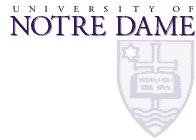

Notre Dame's Howard Blackstead says there's a good reason for the lack of progress in understanding high-temperature superconductivity in the layered perovskites: Everyone has been looking in the wrong place. The associate professor of physics, along with John Dow, a former Notre Dame colleague now at Arizona State University, presented a radical new model of the phenomenon in January of 1995 at a University of Miami workshop on superconductivity.
Their theory locates the conducting property in a different portion of the ceramic's crystal structure than does the conventional model. The key to the phenomenon, they argue, is oxygen located in a region of the crystal known as the "chain layer." The conventional view holds that an adjacent area known as the "cuprate plane" is responsible for superconductivity, since it is the site of the metallic atoms in the ceramic compound. But Blackstead and Dow contend that the cuprate plane really serves as an "anvil" that compresses the oxygen atoms into a metallic superconducting state.
"We can organize an enormous amount of apparently contradictory data with this very simple picture," Blackstead asserts. The physicists formulated their theory after re-examining data already published and noticing some telltale inconsistencies that pointed to chain layer oxygen.
To begin with, they noticed that the ceramic compounds violate a basic rule of freshman chemistry: They do not have balanced charges and therefore should not exist. That paradox, which other researchers had overlooked, can only be resolved if the oxygen is in a peculiar charge state known as "undercharged."
Magnetism, which disrupts superconductivity, yielded another clue pointing to oxygen. Blackstead and Dow observed that a magnetic ion positioned in the crystal structure next to the cuprate plane had no effect on superconductivity; but if the magnetic ion were placed close to the chain layer, it depressed the transition temperature and destroyed superconductivity.
"This suggests that superconductivity isn't in the cuprate plane, as everyone had insisted," Blackstead argues. "It shows that it's in the chain layer, where our undercharged oxygen 'lives.'"
A strange rare-earth ceramic called Praseodymium 1-2-3 provided supporting evidence. The compound is structurally and chemically similar to known superconductors but has baffled scientists because it shows no signs of the superconducting properties.
Blackstead and Dow hypothesized that wayward Praseodymium atoms, which are magnetic, may dampen superconductivity. If some of these atoms settle into the wrong niches, next to the chain layer, they reasoned, they would kill the superconductivity.
To test the hypothesis, the physicists analyzed some Praseodymium 1-2-3 specially prepared to prevent the flaw, tested it, and found evidence of superconductivity -- just as predicted.
"This was pretty exciting stuff," Blackstead says. "We showed that a material everyone thinks is not a superconductor can be one -- if you make it right."
Blackstead and Dow believe their model can move research in a more promising direction. If they're correct, room temperature superconductivity may eventually be attainable. "The back-of-the-matchbook calculations suggest this," the Notre Dame physicist says. "But there still are formidable obstacles. It's a question of finding the right atoms to squeeze oxygen with."
The theory has fueled a supercharged debate within the physics community. "I'm not sure we've convinced many of our colleagues yet," shrugs Blackstead. "But we can explain a lot of things that no one else can, and we've made a lot of people uneasy. At the least, we've forced people to reconsider some things which had been icons of faith."